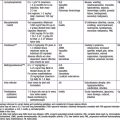Chapter 467 Plasma Transfusions
Guidelines for plasma transfusion in children (see Table 467-1![]() on the Nelson Textbook of Pediatrics website at www.expertconsult.com) are similar to those for adults. Plasma is transfused to replace clinically significant deficiencies of plasma proteins (nearly always clotting proteins) for which more highly purified concentrates are not available. Two interchangeable plasma products are available for transfusion, plasma frozen within 8 hr of collection (fresh frozen plasma) and plasma frozen within 24 hr of collection. Although levels of factors V and VIII are lower in the latter plasma product, they are equally efficacious for literally all indications for plasma transfusions (see Table 467-1). Requirements for plasma vary with the specific protein being replaced, but a starting dose of 15 mL/kg is usually satisfactory.
on the Nelson Textbook of Pediatrics website at www.expertconsult.com) are similar to those for adults. Plasma is transfused to replace clinically significant deficiencies of plasma proteins (nearly always clotting proteins) for which more highly purified concentrates are not available. Two interchangeable plasma products are available for transfusion, plasma frozen within 8 hr of collection (fresh frozen plasma) and plasma frozen within 24 hr of collection. Although levels of factors V and VIII are lower in the latter plasma product, they are equally efficacious for literally all indications for plasma transfusions (see Table 467-1). Requirements for plasma vary with the specific protein being replaced, but a starting dose of 15 mL/kg is usually satisfactory.
Table 467-1 GUIDELINES FOR PEDIATRIC PLASMA TRANSFUSIONS*
INFANTS, CHILDREN, AND ADOLESCENTS
* Words in italics must be defined for local transfusion guidelines.
Transfusion of plasma is efficacious for the treatment of deficiencies of clotting factors II, V, X, and XI. Deficiencies of factor XIII and fibrinogen are treated with cryoprecipitate. Transfusion of plasma is not recommended for the treatment of patients with severe hemophilia A or B, von Willebrand disease, or factor VII deficiency, because safer factor VII, VIII, and IX concentrates are available. Moreover, mild to moderate hemophilia A and certain types of von Willebrand disease can be treated with desmopressin (Chapter 471). An important use of plasma is for rapid reversal of the effects of warfarin in patients who are actively bleeding or who require emergency surgery (in whom functional deficiencies of factors II, VII, IX, and X cannot be rapidly reversed by vitamin K). Results of screening coagulation tests (prothrombin, activated partial thromboplastin, and thrombin times) should not be assumed by themselves to reflect the integrity of the coagulation system or regarded as indications for plasma transfusions. To justify plasma transfusion, coagulation test results must be related to the patient’s clinical condition. Transfusion of plasma in patients with chronic liver disease and prolonged clotting times is not recommended unless bleeding is present or an invasive procedure is planned, because correction of the clotting factor deficiencies is brief.
Felderhoff-Mueser U, Buhrer C. Clinical measures to preserve cerebral integrity in preterm infants. Early Hum Dev. 2005;81:237-244.
Goldenberg NA, Manco-Johnson MJ. Pediatric hemostasis and use of plasma components. Best Pract Res Clin Haematol. 2006;19:143-155.
O’Shaughnessy DF, Atterbury C, Bolton Maggs P, et al. Guidelines for the use of fresh-frozen plasma, cryoprecipitate and cryosupernatant. Br J Haematol. 2004;126:11-28.
Stanworth SJ, Brunskill SJ, Hyde CJ, et al. Is fresh frozen plasma clinically effective? A systematic review of randomized controlled trials. Br J Haematol. 2004;126:139-152.




